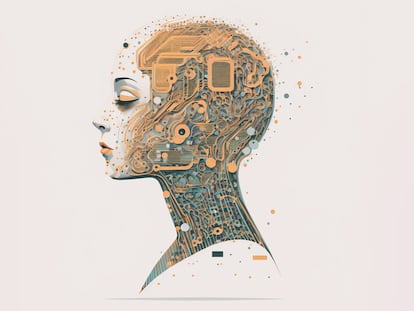Google presents Bard, its answer to ChatGPT
‘AI is the most profound technology we are working on today,’ said the company

The popularity of ChatGPT has caught the attention of big tech. Two weeks ago, Microsoft announced a $10 billion investment in OpenAI, the creator of the chatbot that has popularized generative artificial intelligence (AI) systems. And on Monday, Google presented Bard, its own AI chatbot.
The tool, which is currently in the testing phase, works very similar to ChatGPT, although Google says that it is more powerful and reliable. “It draws on information from the web to provide fresh, high-quality responses. Bard can be an outlet for creativity, and a launchpad for curiosity, helping you to explain new discoveries from NASA’s James Webb Space Telescope to a nine-year-old, or learn more about the best strikers in football right now, and then get drills to build your skills,” Google CEO Sundar Pichai said in a Monday blog post.
Pichai has been emphasizing the importance of artificial intelligence for the past six years, with one of the most visible byproducts materializing in 2021 as part of a system called “Language Model for Dialogue Applications,” or LaMDA, which will be used to power Bard. Introduced two years ago, LaMDA grabbed international headlines last summer, when engineer Blake Lemoine – who was commissioned to review if the robot’s responses showed prejudice – said that he believed the company’s AI technology had become sentient. He was later fired.
The developers behind Bard, the stripped down model of LaMDA, have made the chatbot available to a group of external engineers who are testing it for bugs. As soon as the necessary improvements are done, it will be offered to the general public. The goal is to make sure Bard’s responses “meet a high bar for quality, safety and groundedness in real-world information,” said Pichai.
Google wants to ensure that Bard does not make the same mistake as ChatGPT: make up answers when it doesn’t know how to respond. Bard is part of a series of tools based on generative artificial intelligence that Google is launching on the market. One of the latest is MusicLM, which can create original music from a text provided by the user. The company says it is “creating entirely new ways to engage with information, from language and images to video and audio. We’re working to bring these latest AI advancements into our products, starting with Search.”
Google is one of the companies that has dedicated the most time and money to AI-related research. Its Google Brain division and the British company DeepMind, which it acquired in 2014, are among the world’s leaders in the field. In fact, the Transformer research project and its founding article, presented in 2017, is the touchstone upon which the scientific community has built advanced generative artificial intelligence.
Last summer, the public was amazed by other AI programs, such as the Dall-E2 and Midjourney text-based image generators. And after OpenAI launched ChatGPT in November, big tech has been rushing to complete projects that incorporate similar tools. Google has been the last to join the wave.
hello from redmond! excited for the event tomorrow pic.twitter.com/b7TUr0ti42
— Sam Altman (@sama) February 6, 2023
“AI is the most profound technology we are working on today. Whether it’s helping doctors detect diseases earlier or enabling people to access information in their own language, AI helps people, businesses and communities unlock their potential,” said Pichai in his blog post. “That’s why we re-oriented the company around AI six years ago – and why we see it as the most important way we can deliver on our mission: to organize the world’s information and make it universally accessible and useful.”
“Today, the scale of the largest AI computations is doubling every six months, far outpacing Moore’s Law,” he added. The race to lead the field of generative artificial intelligence is on.
Sign up for our weekly newsletter to get more English-language news coverage from EL PAÍS USA Edition.
Tu suscripción se está usando en otro dispositivo
¿Quieres añadir otro usuario a tu suscripción?
Si continúas leyendo en este dispositivo, no se podrá leer en el otro.
FlechaTu suscripción se está usando en otro dispositivo y solo puedes acceder a EL PAÍS desde un dispositivo a la vez.
Si quieres compartir tu cuenta, cambia tu suscripción a la modalidad Premium, así podrás añadir otro usuario. Cada uno accederá con su propia cuenta de email, lo que os permitirá personalizar vuestra experiencia en EL PAÍS.
¿Tienes una suscripción de empresa? Accede aquí para contratar más cuentas.
En el caso de no saber quién está usando tu cuenta, te recomendamos cambiar tu contraseña aquí.
Si decides continuar compartiendo tu cuenta, este mensaje se mostrará en tu dispositivo y en el de la otra persona que está usando tu cuenta de forma indefinida, afectando a tu experiencia de lectura. Puedes consultar aquí los términos y condiciones de la suscripción digital.
More information
Archived In
Últimas noticias
All states where the minimum wage will increase in 2026
Los Chapitos in crisis: Caught between internal feuds and pressure from authorities
Trump escalates tensions with the EU by sanctioning officials who fight online hate speech
CBS in crisis after pulling a report on Trump’s deportations to El Salvador (which later leaked online)
Most viewed
- Liset Menéndez de la Prida, neuroscientist: ‘It’s not normal to constantly seek pleasure; it’s important to be bored, to be calm’
- Christian Louboutin: ‘Young people don’t want to be like their parents. And if their parents wear sneakers, they’re going to look for something else’
- December Social Security and SSI payments: Dates, double checks and the 2026 COLA increase
- The low-cost creative revolution: How technology is making art accessible to everyone
- All the effects of gentrification in one corner of Mexico’s Colonia Roma











































